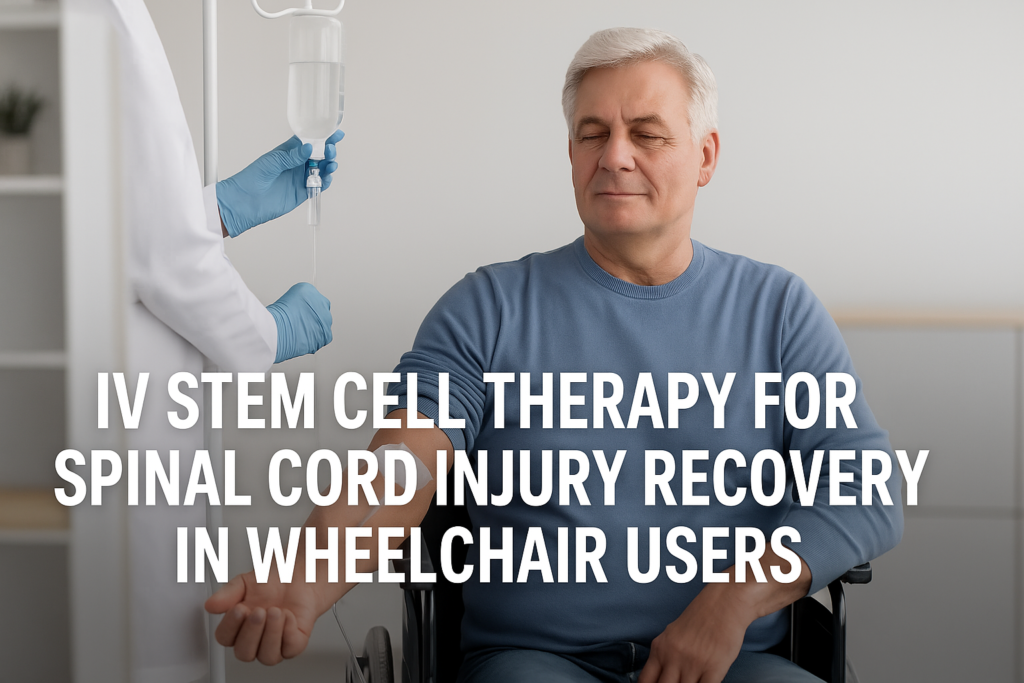IV Stem Cell Therapy: A Promising Treatment for Spinal Cord Injury Recovery in Wheelchair Users

Spinal cord injuries (SCI) are among the most life-altering conditions, often leaving individuals reliant on wheelchairs due to paralysis or severe mobility impairments. Traditional treatments focus on rehabilitation and symptom management, but emerging regenerative therapies, such as intravenous (IV) stem cell therapy, offer new hope for recovery. While still an evolving field, IV stem cell therapy has shown potential in helping wheelchair users regain mobility and improve their quality of life.
Understanding IV Stem Cell Therapy
IV stem cell therapy involves injecting stem cells directly into the bloodstream. These cells travel through the body, potentially targeting damaged areas of the spinal cord and promoting tissue repair. Unlike direct spinal cord injections, which are more invasive, IV administration is a minimally invasive alternative that allows stem cells to distribute systemically and seek out sites of inflammation and injury.

Sources of Stem Cells Used in IV Therapy
Stem cells used in this therapy can be derived from various sources, including:
- Umbilical Cord (Wharton’s Jelly) – Donated after birth, these mesenchymal stem cells (MSCs) are highly potent and widely used.
- Bone Marrow-Derived Stem Cells – Taken from the patient or a donor, though extraction can be invasive.
- Adipose Tissue (Fat Cells) – Harvested via liposuction, rich in MSCs that promote regeneration.
- Induced Pluripotent Stem Cells (iPSCs) – Reprogrammed from adult cells, still in experimental phases.
How IV Stem Cell Therapy Helps Spinal Cord Injury Patients
For individuals in wheelchairs due to spinal cord injuries, IV stem cell therapy aims to:
- Reduce Inflammation – SCI often leads to chronic inflammation, which further damages nerves. Stem cells help suppress this inflammatory response.
- Stimulate Nerve Regeneration – Stem cells may encourage the repair and regrowth of nerve fibers (axons) in the damaged spinal cord.
- Enhance Motor Function – Some patients have reported improvements in muscle control and coordination.
- Improve Sensory Perception – Restoration of sensation, even partially, can significantly enhance quality of life.
- Support Bladder and Bowel Function – Many SCI patients struggle with autonomic functions, and stem cell therapy may aid in restoring control.
Clinical Evidence and Case Studies
While research is ongoing, several studies have shown promising results:
- A 2021 study published in Stem Cells Translational Medicine found that IV-administered MSCs improved motor function and reduced inflammation in patients with chronic spinal cord injuries.
- A small clinical trial in 2023 reported that some wheelchair-bound individuals experienced partial limb movement recovery following IV stem cell treatment.
However, outcomes vary depending on factors such as injury severity, time since the accident, and individual response to therapy.
Potential Risks and Considerations
Like any medical treatment, IV stem cell therapy has potential risks:
- Variable Effectiveness – Not all patients experience significant improvements.
- Immune Response – The body may reject donor stem cells.
- Unregulated Clinics – Many clinics operate without FDA approval, so choosing a reputable provider is crucial.
- Cost – Treatment can be expensive and is often not covered by insurance.
The Future of IV Stem Cell Therapy for SCI
Research is advancing rapidly, with new techniques enhancing the ability of stem cells to integrate into the spinal cord and promote healing. Combined with physical therapy and other regenerative approaches, IV stem cell therapy may soon become a standard option for spinal cord injury patients seeking to regain mobility.
Final Thoughts
For individuals in wheelchairs due to spinal cord injuries, IV stem cell therapy represents a groundbreaking frontier in regenerative medicine. While it is not yet a guaranteed cure, the potential for improved movement, sensation, and overall quality of life offers hope to many. As research continues, this therapy may unlock new possibilities for spinal cord injury recovery, helping those affected move closer to independence and mobility once again.



